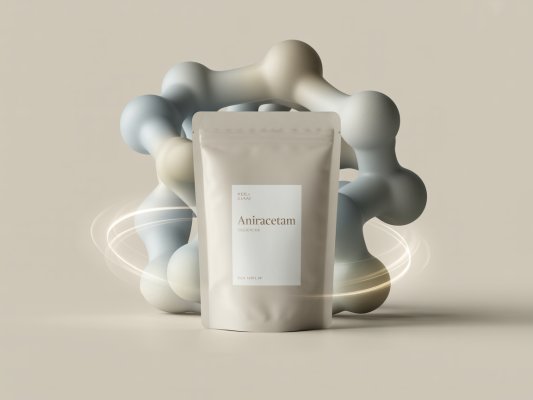
Aniracetam
Description
Aniracetam is a nootropic compound belonging to the racetam family, lauded for its potential to enhance cognitive function. Unlike some of its counterparts, Aniracetam is fat-soluble, influencing its absorption and duration of effects. This article provides a comprehensive yet accessible guide to Aniracetam, covering its mechanisms, benefits, and practical considerations.
Quick Overview: Aniracetam At-a-Glance
- Key Benefits: Improved memory, focus, and potentially mood.
- Primary Mechanism: Modulates AMPA receptors, influencing glutamate, dopamine and serotonin.
- Best For: Individuals seeking a cognitive boost, particularly those with mild cognitive impairment.
- Typical Dose Range: 600-1500mg daily, divided into multiple doses.
- Key Consideration: It's fat-soluble, so take with a meal containing fats for best absorption.
Table of Contents
Categories & Effectiveness
Learn about our rating methodologyBrain Health
Acetylcholine Support
5/10Moderate evidence of effectiveness
Dopamine Support
4/10Moderate evidence of effectiveness
Neurogenesis (BDNF/NGF)
4/10Moderate evidence of effectiveness
Serotonin Support
4/10Moderate evidence of effectiveness
Cognition
Memory & Recall
5/10Moderate evidence of effectiveness
Mental Acuity
4/10Moderate evidence of effectiveness
Impulse Control
2/10Limited evidence of effectiveness
Mood & Stress
Mood Elevation
4/10Moderate evidence of effectiveness
Emotional Stability
3/10Limited evidence of effectiveness
Dosage & Side Effects
Recommended Dosage
Key Dosage Tips:
- Experiment to find your optimal dose within the recommended range.
- Start with a lower dose (e.g., 600mg) and gradually increase as needed.
Potential Side Effects
Bioavailability & Half-Life
Interactions & Stacks
Recommended Products
MSM + Vitamin C Powder - MSM Powder for Hair Growth & Nail Strength - MSM Supplement for Joint Flexibility - Wildberry MSM Sulfur Powder 30 Servings Non-GMO & Gluten Free - 7.9 Oz
- Rated 4.6 stars by 187 customers
- Premium quality ingredients
Nausea Relief Inhaler - All-Natural Remedy for Motion Sickness, Morning Sickness, Stress, and Queasiness - Fast-Acting, Drug-Free, Non-Drowsy & Portable Travel Essential - Pack of 2 Inhalers
- Rated 4.4 stars by 1,079 customers
- Premium quality ingredients
Horsetail Extract, Biotin & Collagen Beauty Gummies - Hair Skin & Nails Vitamins for Women - Hair Growth Vitamin with Saw Palmetto, D3, Zinc & Fo-Ti - Vegan Supplements for Kids & Adults - Made in USA
- Rated 4.4 stars by 23 customers
- Premium quality ingredients
As an Amazon Associate we earn from qualifying purchases. Prices and availability are accurate as of the date/time indicated and are subject to change.
Benefits by Use Case
Enhanced Memory & Recall
May improve memory formation and recall, particularly in individuals with age-related cognitive decline. However, results vary, and more research is needed for healthy individuals.
User Review:
Users report improved ability to remember details and recall information more quickly.
Improved Focus & Mental Acuity
Some users report enhanced focus and mental clarity, making it easier to concentrate on tasks. This effect may be linked to Aniracetam's modulation of neurotransmitter systems.
User Review:
Helps me stay focused and productive throughout the day.
Mood Elevation & Anxiety Reduction
May have anxiolytic and antidepressant effects, promoting a sense of well-being and reducing anxiety symptoms. These effects are likely due to its influence on dopamine and serotonin.
User Review:
I feel more relaxed and positive since starting Aniracetam.
Sociability & Verbal Fluidity
Some users report improved sociability and ease of communication. This effect might be related to enhanced dopamine and serotonin activity.
User Review:
I find it easier to engage in conversations and express myself.
Mechanism of Action
Frequently Asked Questions
Where to Buy Aniracetam
Based on quality, price, and customer reviews, here are our top recommended Aniracetam supplements:
Nausea Relief Inhaler - All-Natural Remedy for Motion Sickness, Morning Sickness, Stress, and Queasiness - Fast-Acting, Drug-Free, Non-Drowsy & Portable Travel Essential - Pack of 2 Inhalers
- Rated 4.4 stars by 1,079 customers
- Premium quality ingredients
It's Just! - Whey Protein Isolate, Ultra Premium Grass-Fed, Unflavored, Made in USA, Pure 90% Protein, Only 1g Carb, No Added Sugar (5 Pound)
- Rated 4.3 stars by 239 customers
- Premium quality ingredients
Primal Harvest Hair Growth Vitamins, 2 Pack - 120 Pills, Natural Hair Regrowth, Thickening, and Supplement for Men & Women with Biotin & Zinc
- Rated 4.4 stars by 205 customers
- Premium quality ingredients
As an Amazon Associate we earn from qualifying purchases. Prices and availability are accurate as of the date/time indicated and are subject to change.
Summary & Expert Opinion
For those seeking a deeper understanding, Aniracetam's primary action involves positive allosteric modulation of AMPA receptors. This means it enhances the receptors' response to glutamate, the brain's main excitatory neurotransmitter. Unlike some nootropics that directly stimulate receptors, Aniracetam amplifies existing neuronal activity, potentially leading to a more natural and nuanced cognitive boost. The influence of Aniracetam on dopamine and serotonin release, mediated by its metabolite N-anisoyl-GABA, adds another layer of complexity, potentially contributing to its anxiolytic and mood-enhancing effects.
Several studies suggest Aniracetam's potential in preventing amyloid-beta (Aβ) plaque accumulation, a hallmark of Alzheimer's disease. This is theorized to occur through two primary pathways: increasing Brain-Derived Neurotrophic Factor (BDNF) expression and positively modulating metabotropic glutamate receptors (mGluRs), both of which can enhance α-secretase activity. However, this model is based on preliminary evidence, and more research is needed to confirm these effects in vivo.
The study by Koliaki et al. (2012) revealed that Aniracetam monotherapy maintained neuropsychological parameters over 12 months and improved emotional state at 3 months in patients with cognitive disorders. Notably, in patients with mild-to-moderate dementia, Aniracetam showed better cognitive performance at 6 months and improved functionality at 3 months compared to cholinesterase inhibitors (ChEIs) alone. These findings, while promising, come from an open-label study, which has inherent limitations.
While Aniracetam demonstrates potential benefits, it's crucial to acknowledge the knowledge gaps and "gray areas". The exact mGluRs modulated and the specific α-secretases activated by Aniracetam remain unclear. Moreover, the long-term effects of chronically upregulating α-secretase activity are still under investigation. Therefore, consulting with a healthcare professional is essential before incorporating Aniracetam into a cognitive enhancement regimen.









